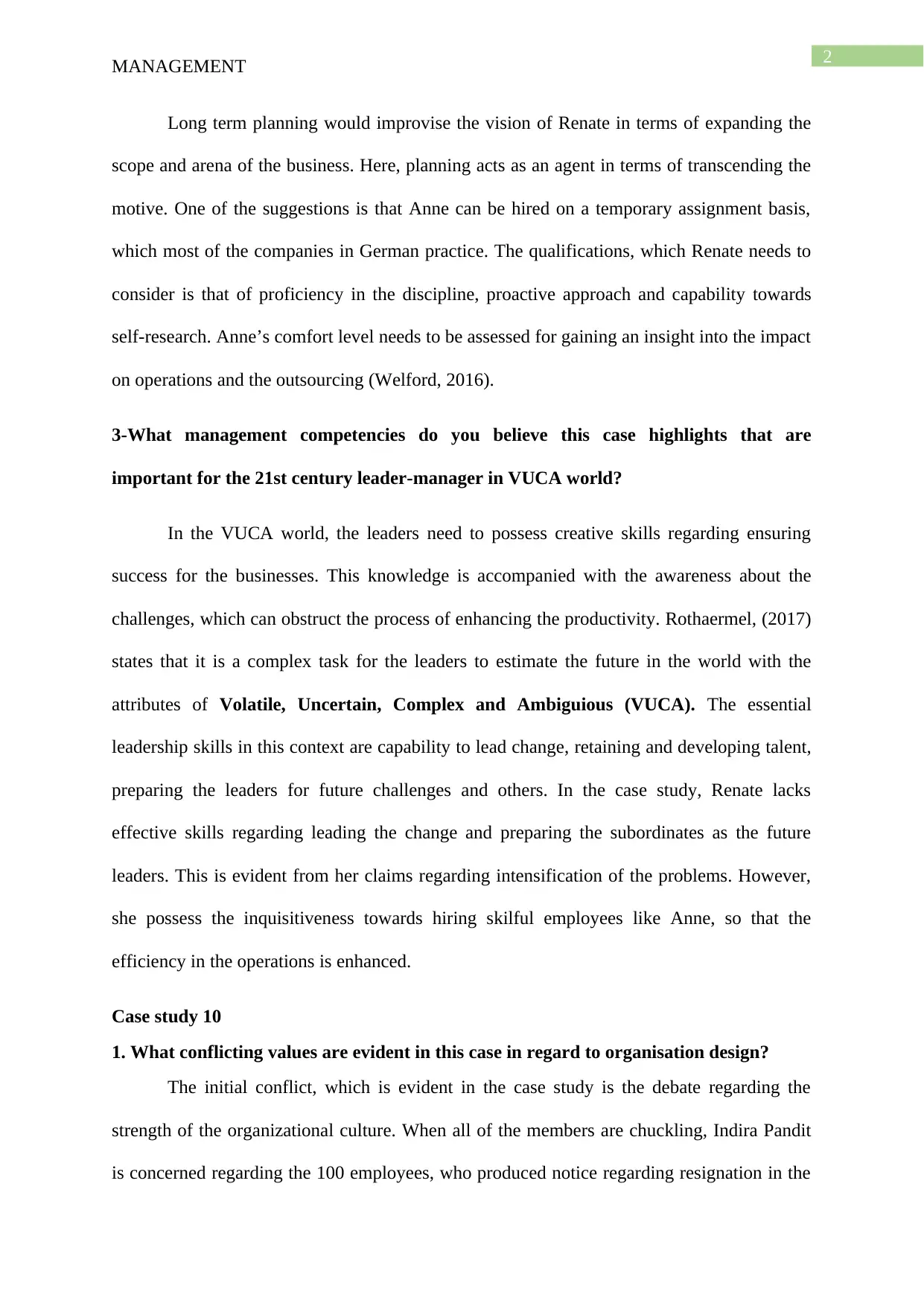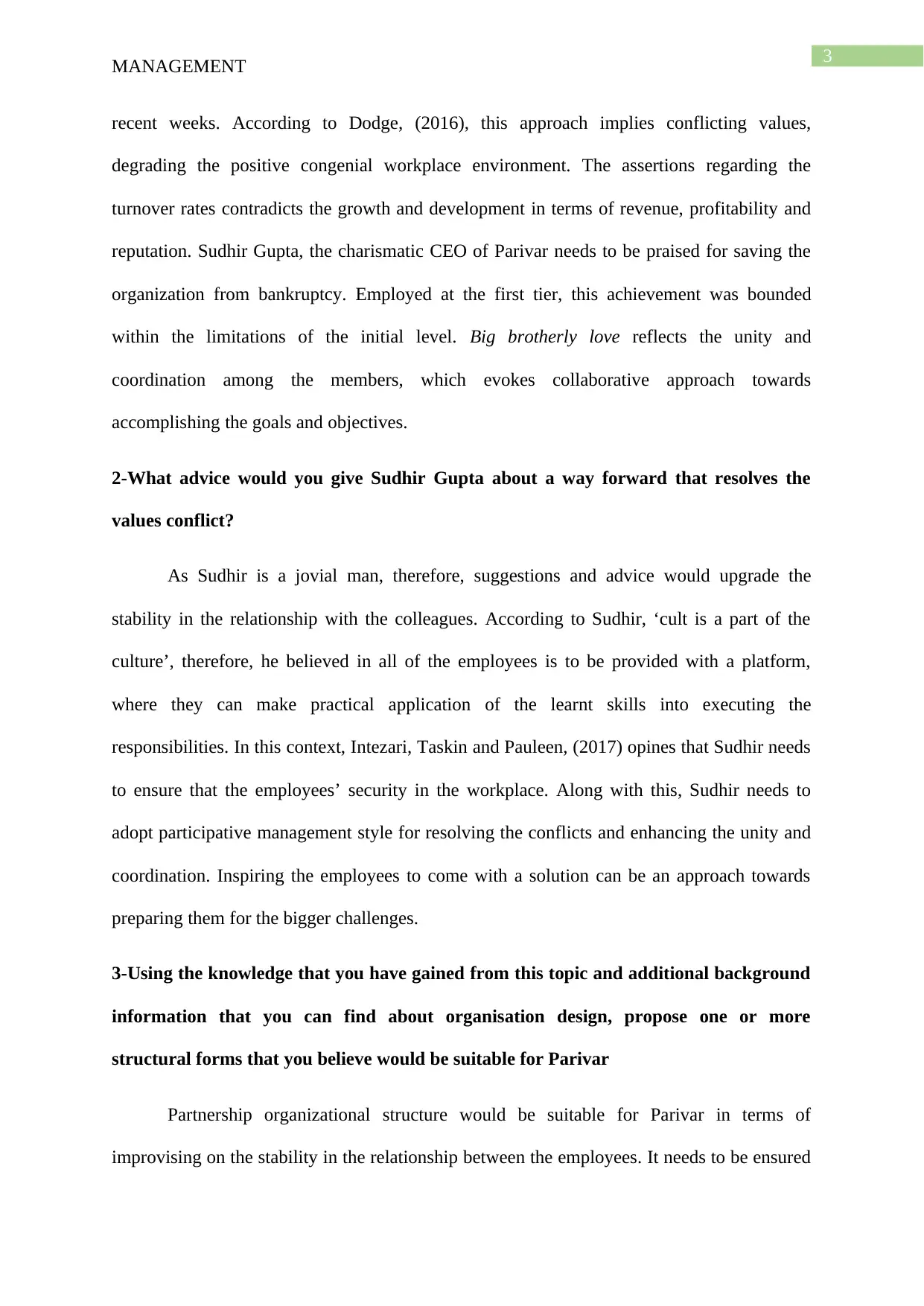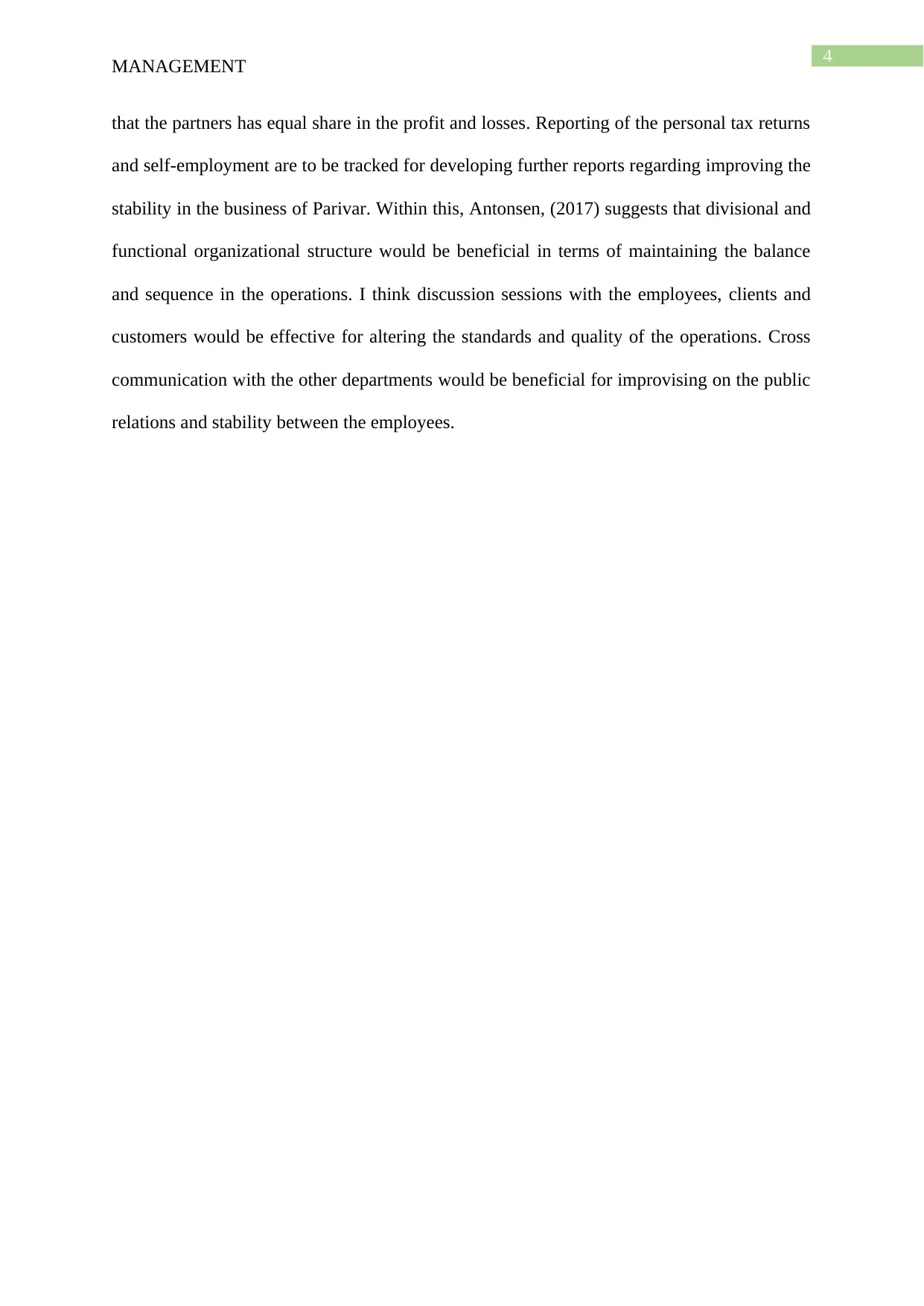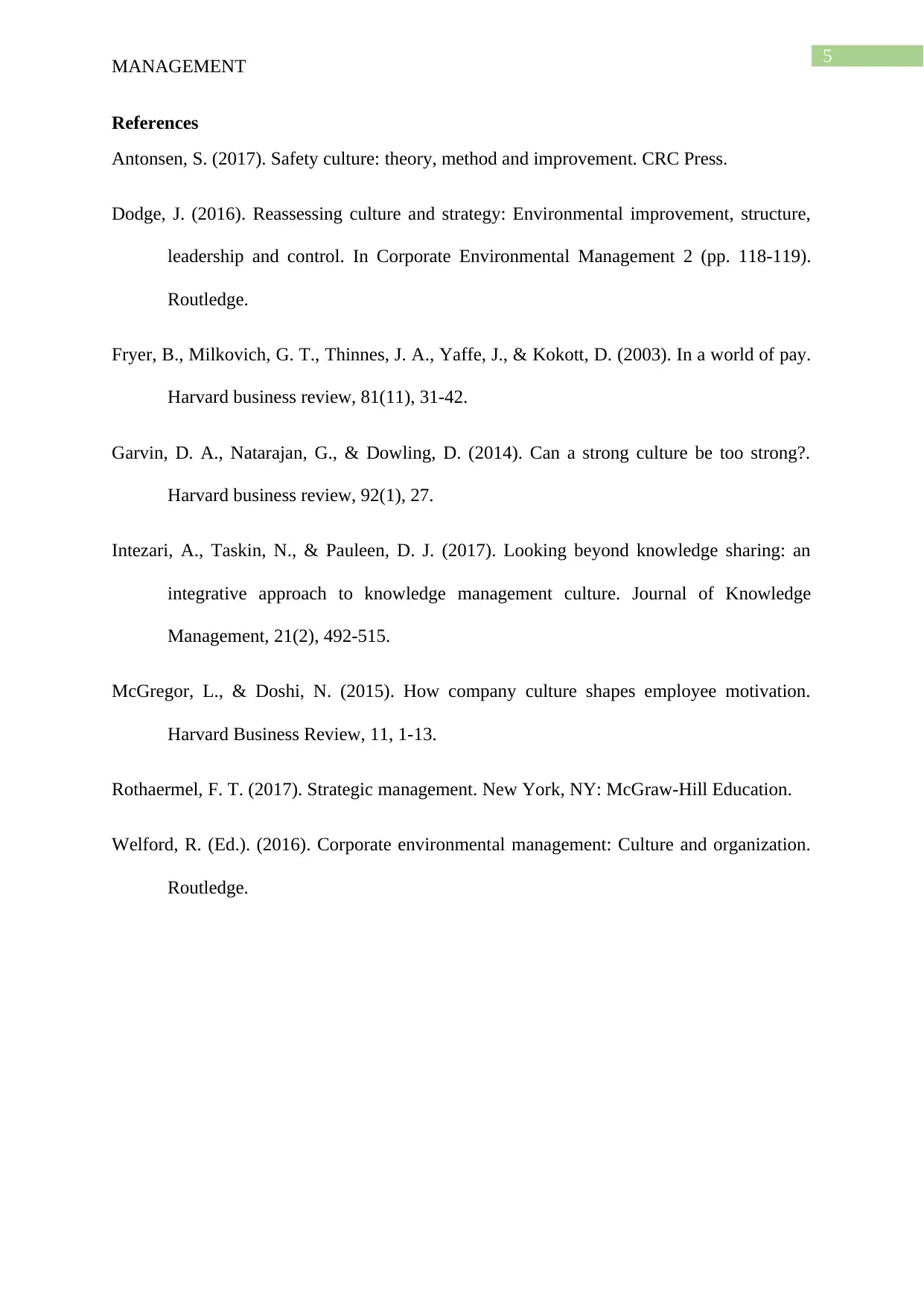University Management Case Study: Values Conflicts and Solutions
VerifiedAdded on 2022/08/23
|6
|1401
|15
Case Study
AI Summary
This case study analysis examines two management cases. The first case explores conflicting values within an organization, focusing on the challenges faced by Renate Schmidt, the head of HR, in navigating these conflicts and offering solutions. The second case delves into the organizational design and values conflicts at Parivar, a Chennai-based IT services company, highlighting the challenges faced by CEO Sudhir Gupta. The analysis identifies conflicting values, proposes solutions, and discusses management competencies essential for 21st-century leaders in a VUCA world. The document provides a detailed overview of the cases, offering insights into organizational culture, leadership, and strategic management, along with relevant references.

Running head: MANAGEMENT
Contemporary management
Name of the student:
Name of the university:
Author note:
Contemporary management
Name of the student:
Name of the university:
Author note:
Paraphrase This Document
Need a fresh take? Get an instant paraphrase of this document with our AI Paraphraser

1
MANAGEMENT
Case study 9
1. What conflicting values are evident in this case?
According to the business leaders, strong and flexible organizational culture is the key
towards attaining success. On the contrary, very few possess the knowledge regarding
preserving the organizational culture and the core values. Intuitive perceptions comes in a
way of enhancing the organizational culture, which is an obstacle towards upgrading the
unity and coordination. Conflicts also prevail in the management style of enhancing the
workplace culture. One of the first parameter is that of measuring the impact on the bottom
line. Alteration of the motives of business assisted the workers to expose better performance.
McGregor and Doshi, (2015) asserts that the main reasons for which the people work are
play, purpose, potential, emotional pressure, economic pressure and inertia. On the contrary,
Fryer et al., (2003) is of the view that motives related to the purpose of employment and the
potential of the workers tends to upgrade the standards and quality of the performance.
2-What advice would you give Renate Schmidt about a way forward that resolves the
values conflict?
The problem, which Renate encountered is that of aggravating complexities in the
process of resolving the issues. The European head of marketing expressed his disinterest
towards the revised selection and recruitment policies. Advertising campaigns boosted the
sales. The contracts and offers evoked conflicts between Renate and Jurgen, which was unfair
and humiliating. Renate can consider problem solving cycle for upgrading the approach
towards achieving effective resolutions. Along with this, Garvin, Natarajan and Dowling,
(2014) states that Gibbs reflective cycle can also be considered for evaluating the
appropriateness of the strategies formulated towards resolving the issues. Using checklists
and templates can be beneficial in terms of re-checking whether the approach aligns with the
expectations and requirements of the clients and customers.
MANAGEMENT
Case study 9
1. What conflicting values are evident in this case?
According to the business leaders, strong and flexible organizational culture is the key
towards attaining success. On the contrary, very few possess the knowledge regarding
preserving the organizational culture and the core values. Intuitive perceptions comes in a
way of enhancing the organizational culture, which is an obstacle towards upgrading the
unity and coordination. Conflicts also prevail in the management style of enhancing the
workplace culture. One of the first parameter is that of measuring the impact on the bottom
line. Alteration of the motives of business assisted the workers to expose better performance.
McGregor and Doshi, (2015) asserts that the main reasons for which the people work are
play, purpose, potential, emotional pressure, economic pressure and inertia. On the contrary,
Fryer et al., (2003) is of the view that motives related to the purpose of employment and the
potential of the workers tends to upgrade the standards and quality of the performance.
2-What advice would you give Renate Schmidt about a way forward that resolves the
values conflict?
The problem, which Renate encountered is that of aggravating complexities in the
process of resolving the issues. The European head of marketing expressed his disinterest
towards the revised selection and recruitment policies. Advertising campaigns boosted the
sales. The contracts and offers evoked conflicts between Renate and Jurgen, which was unfair
and humiliating. Renate can consider problem solving cycle for upgrading the approach
towards achieving effective resolutions. Along with this, Garvin, Natarajan and Dowling,
(2014) states that Gibbs reflective cycle can also be considered for evaluating the
appropriateness of the strategies formulated towards resolving the issues. Using checklists
and templates can be beneficial in terms of re-checking whether the approach aligns with the
expectations and requirements of the clients and customers.

2
MANAGEMENT
Long term planning would improvise the vision of Renate in terms of expanding the
scope and arena of the business. Here, planning acts as an agent in terms of transcending the
motive. One of the suggestions is that Anne can be hired on a temporary assignment basis,
which most of the companies in German practice. The qualifications, which Renate needs to
consider is that of proficiency in the discipline, proactive approach and capability towards
self-research. Anne’s comfort level needs to be assessed for gaining an insight into the impact
on operations and the outsourcing (Welford, 2016).
3-What management competencies do you believe this case highlights that are
important for the 21st century leader-manager in VUCA world?
In the VUCA world, the leaders need to possess creative skills regarding ensuring
success for the businesses. This knowledge is accompanied with the awareness about the
challenges, which can obstruct the process of enhancing the productivity. Rothaermel, (2017)
states that it is a complex task for the leaders to estimate the future in the world with the
attributes of Volatile, Uncertain, Complex and Ambiguious (VUCA). The essential
leadership skills in this context are capability to lead change, retaining and developing talent,
preparing the leaders for future challenges and others. In the case study, Renate lacks
effective skills regarding leading the change and preparing the subordinates as the future
leaders. This is evident from her claims regarding intensification of the problems. However,
she possess the inquisitiveness towards hiring skilful employees like Anne, so that the
efficiency in the operations is enhanced.
Case study 10
1. What conflicting values are evident in this case in regard to organisation design?
The initial conflict, which is evident in the case study is the debate regarding the
strength of the organizational culture. When all of the members are chuckling, Indira Pandit
is concerned regarding the 100 employees, who produced notice regarding resignation in the
MANAGEMENT
Long term planning would improvise the vision of Renate in terms of expanding the
scope and arena of the business. Here, planning acts as an agent in terms of transcending the
motive. One of the suggestions is that Anne can be hired on a temporary assignment basis,
which most of the companies in German practice. The qualifications, which Renate needs to
consider is that of proficiency in the discipline, proactive approach and capability towards
self-research. Anne’s comfort level needs to be assessed for gaining an insight into the impact
on operations and the outsourcing (Welford, 2016).
3-What management competencies do you believe this case highlights that are
important for the 21st century leader-manager in VUCA world?
In the VUCA world, the leaders need to possess creative skills regarding ensuring
success for the businesses. This knowledge is accompanied with the awareness about the
challenges, which can obstruct the process of enhancing the productivity. Rothaermel, (2017)
states that it is a complex task for the leaders to estimate the future in the world with the
attributes of Volatile, Uncertain, Complex and Ambiguious (VUCA). The essential
leadership skills in this context are capability to lead change, retaining and developing talent,
preparing the leaders for future challenges and others. In the case study, Renate lacks
effective skills regarding leading the change and preparing the subordinates as the future
leaders. This is evident from her claims regarding intensification of the problems. However,
she possess the inquisitiveness towards hiring skilful employees like Anne, so that the
efficiency in the operations is enhanced.
Case study 10
1. What conflicting values are evident in this case in regard to organisation design?
The initial conflict, which is evident in the case study is the debate regarding the
strength of the organizational culture. When all of the members are chuckling, Indira Pandit
is concerned regarding the 100 employees, who produced notice regarding resignation in the
⊘ This is a preview!⊘
Do you want full access?
Subscribe today to unlock all pages.

Trusted by 1+ million students worldwide

3
MANAGEMENT
recent weeks. According to Dodge, (2016), this approach implies conflicting values,
degrading the positive congenial workplace environment. The assertions regarding the
turnover rates contradicts the growth and development in terms of revenue, profitability and
reputation. Sudhir Gupta, the charismatic CEO of Parivar needs to be praised for saving the
organization from bankruptcy. Employed at the first tier, this achievement was bounded
within the limitations of the initial level. Big brotherly love reflects the unity and
coordination among the members, which evokes collaborative approach towards
accomplishing the goals and objectives.
2-What advice would you give Sudhir Gupta about a way forward that resolves the
values conflict?
As Sudhir is a jovial man, therefore, suggestions and advice would upgrade the
stability in the relationship with the colleagues. According to Sudhir, ‘cult is a part of the
culture’, therefore, he believed in all of the employees is to be provided with a platform,
where they can make practical application of the learnt skills into executing the
responsibilities. In this context, Intezari, Taskin and Pauleen, (2017) opines that Sudhir needs
to ensure that the employees’ security in the workplace. Along with this, Sudhir needs to
adopt participative management style for resolving the conflicts and enhancing the unity and
coordination. Inspiring the employees to come with a solution can be an approach towards
preparing them for the bigger challenges.
3-Using the knowledge that you have gained from this topic and additional background
information that you can find about organisation design, propose one or more
structural forms that you believe would be suitable for Parivar
Partnership organizational structure would be suitable for Parivar in terms of
improvising on the stability in the relationship between the employees. It needs to be ensured
MANAGEMENT
recent weeks. According to Dodge, (2016), this approach implies conflicting values,
degrading the positive congenial workplace environment. The assertions regarding the
turnover rates contradicts the growth and development in terms of revenue, profitability and
reputation. Sudhir Gupta, the charismatic CEO of Parivar needs to be praised for saving the
organization from bankruptcy. Employed at the first tier, this achievement was bounded
within the limitations of the initial level. Big brotherly love reflects the unity and
coordination among the members, which evokes collaborative approach towards
accomplishing the goals and objectives.
2-What advice would you give Sudhir Gupta about a way forward that resolves the
values conflict?
As Sudhir is a jovial man, therefore, suggestions and advice would upgrade the
stability in the relationship with the colleagues. According to Sudhir, ‘cult is a part of the
culture’, therefore, he believed in all of the employees is to be provided with a platform,
where they can make practical application of the learnt skills into executing the
responsibilities. In this context, Intezari, Taskin and Pauleen, (2017) opines that Sudhir needs
to ensure that the employees’ security in the workplace. Along with this, Sudhir needs to
adopt participative management style for resolving the conflicts and enhancing the unity and
coordination. Inspiring the employees to come with a solution can be an approach towards
preparing them for the bigger challenges.
3-Using the knowledge that you have gained from this topic and additional background
information that you can find about organisation design, propose one or more
structural forms that you believe would be suitable for Parivar
Partnership organizational structure would be suitable for Parivar in terms of
improvising on the stability in the relationship between the employees. It needs to be ensured
Paraphrase This Document
Need a fresh take? Get an instant paraphrase of this document with our AI Paraphraser

4
MANAGEMENT
that the partners has equal share in the profit and losses. Reporting of the personal tax returns
and self-employment are to be tracked for developing further reports regarding improving the
stability in the business of Parivar. Within this, Antonsen, (2017) suggests that divisional and
functional organizational structure would be beneficial in terms of maintaining the balance
and sequence in the operations. I think discussion sessions with the employees, clients and
customers would be effective for altering the standards and quality of the operations. Cross
communication with the other departments would be beneficial for improvising on the public
relations and stability between the employees.
MANAGEMENT
that the partners has equal share in the profit and losses. Reporting of the personal tax returns
and self-employment are to be tracked for developing further reports regarding improving the
stability in the business of Parivar. Within this, Antonsen, (2017) suggests that divisional and
functional organizational structure would be beneficial in terms of maintaining the balance
and sequence in the operations. I think discussion sessions with the employees, clients and
customers would be effective for altering the standards and quality of the operations. Cross
communication with the other departments would be beneficial for improvising on the public
relations and stability between the employees.

5
MANAGEMENT
References
Antonsen, S. (2017). Safety culture: theory, method and improvement. CRC Press.
Dodge, J. (2016). Reassessing culture and strategy: Environmental improvement, structure,
leadership and control. In Corporate Environmental Management 2 (pp. 118-119).
Routledge.
Fryer, B., Milkovich, G. T., Thinnes, J. A., Yaffe, J., & Kokott, D. (2003). In a world of pay.
Harvard business review, 81(11), 31-42.
Garvin, D. A., Natarajan, G., & Dowling, D. (2014). Can a strong culture be too strong?.
Harvard business review, 92(1), 27.
Intezari, A., Taskin, N., & Pauleen, D. J. (2017). Looking beyond knowledge sharing: an
integrative approach to knowledge management culture. Journal of Knowledge
Management, 21(2), 492-515.
McGregor, L., & Doshi, N. (2015). How company culture shapes employee motivation.
Harvard Business Review, 11, 1-13.
Rothaermel, F. T. (2017). Strategic management. New York, NY: McGraw-Hill Education.
Welford, R. (Ed.). (2016). Corporate environmental management: Culture and organization.
Routledge.
MANAGEMENT
References
Antonsen, S. (2017). Safety culture: theory, method and improvement. CRC Press.
Dodge, J. (2016). Reassessing culture and strategy: Environmental improvement, structure,
leadership and control. In Corporate Environmental Management 2 (pp. 118-119).
Routledge.
Fryer, B., Milkovich, G. T., Thinnes, J. A., Yaffe, J., & Kokott, D. (2003). In a world of pay.
Harvard business review, 81(11), 31-42.
Garvin, D. A., Natarajan, G., & Dowling, D. (2014). Can a strong culture be too strong?.
Harvard business review, 92(1), 27.
Intezari, A., Taskin, N., & Pauleen, D. J. (2017). Looking beyond knowledge sharing: an
integrative approach to knowledge management culture. Journal of Knowledge
Management, 21(2), 492-515.
McGregor, L., & Doshi, N. (2015). How company culture shapes employee motivation.
Harvard Business Review, 11, 1-13.
Rothaermel, F. T. (2017). Strategic management. New York, NY: McGraw-Hill Education.
Welford, R. (Ed.). (2016). Corporate environmental management: Culture and organization.
Routledge.
⊘ This is a preview!⊘
Do you want full access?
Subscribe today to unlock all pages.

Trusted by 1+ million students worldwide
1 out of 6
Related Documents
Your All-in-One AI-Powered Toolkit for Academic Success.
+13062052269
info@desklib.com
Available 24*7 on WhatsApp / Email
![[object Object]](/_next/static/media/star-bottom.7253800d.svg)
Unlock your academic potential
Copyright © 2020–2025 A2Z Services. All Rights Reserved. Developed and managed by ZUCOL.



